MacKelvey's Materials for 4th Grade Earth and Space Sciences: Earth Structure, Processes and Cycles
Don't wanna be here? Send us removal request.
Photo


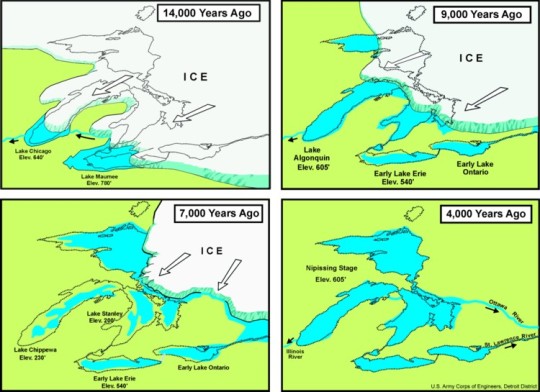



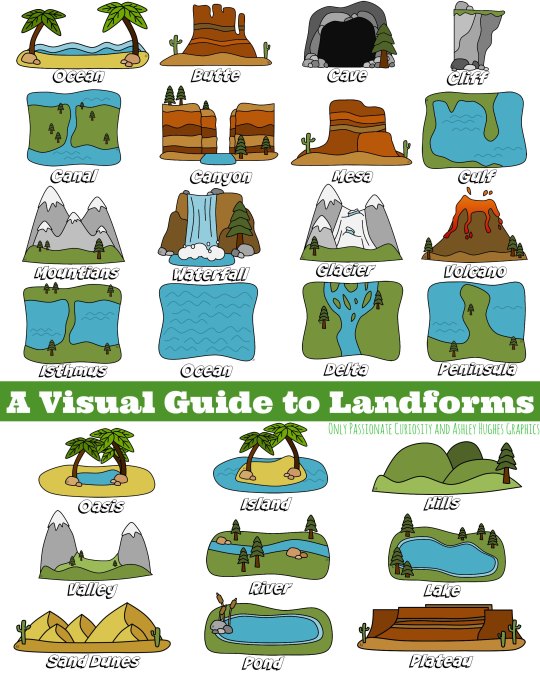
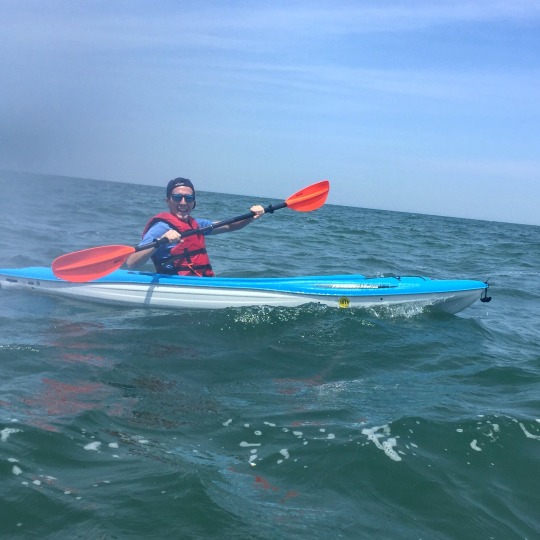
Sunday, January 12th, 2020 (COMPONENT #5)
As I revisit the essential questions that helped shape the twelve standards of focus for developing my curriculum map around “describing basic landforms, identifying layers of Earth, and recognizing that the surface of the earth changes due to slow processes and rapid processes,” I took into much consideration the diverse population of students I work with. From students whom have an Individualized Education Plans, to English as a Second Language students, to gifted students, the materials I chose for my resource bank reach across the spectrum of learners to ensure every student is receiving an appropriate education; from auditory learning, visual learning, and kinesthetic learning, all students will benefit from research-based practices, YouTube videos, and various books. Through doing so, the three resources per standard allow all students in the classroom to reach their potential through variations in mediums, representations, and ways of thinking.
ESSENTIAL QUESTIONS:
· Why is Lake Erie’s shoreline changing shape?
· What causes Lake Erie’s shoreline to change size?
· How does the changing shoreline affect people living in Lakecliff?
· How is the land changing along Lake Erie’s shoreline?
· What are strategies we can use to reduce erosion?
· What materials would work best to hold the shoreline in place?
STANDARDS:
S4.A.3.2.1 Identify what different models represent (e.g., maps show physical features, directions, distances; globes represent Earth; drawings of watersheds depict terrain; dioramas show ecosystems; concept maps show relationships of ideas).
1. Great Lakes Maps Worksheets By Nolan Resources
Great Lakes Maps Worksheets
FREE Great Lakes maps worksheets (n.d.). In Teachers Pay Teachers. Retrieved from https://www.teacherspayteachers.com/Product/FREE-Great-Lakes-Maps-Worksheets-3982437
2. YouTube Video on Know Your Globe By SciShow Kids
Know Your Globe
SciShow Kids. (2016, February 8). Know your globe. [Video]. YouTube. https://www.youtube.com/watch?v=x7k7CeWDtWs
3. Lake Erie Tributaries Map Photograph By BlueAccounting
Lake Erie Tributaries Map Photograph
[Photograph of Lake Erie Tributaries] (2018). Retrieved from: https://www.blueaccounting.org/issue/eriestat
S4.A.3.2.2 Use models to make observations to explain how systems work (e.g., water cycle, Sun-Earth-Moon system).
1. The Water Cycle Rap (DJ H20) Cycle Song By Mr. Lee (Water Cycle Rap)
The Water Cycle Rap
Tfashady410. (2015, May 10). Water cycle rap. [Video]. YouTube.
https://www.youtube.com/watch?v=lLGmddxT178
2. Oreo Moon Phases Worksheets By Science Spot
Oreo Moon Phases Worksheets
Oreo Moon Phases Worksheets (n.d.). In Teachers Pay Teachers. Retrieved from https://www.teacherspayteachers.com/Product/Oreo-Moon-Phases-Worksheets-Space-Science-Astronomy-Unit-Lunar-Cycle-1753687
3. Reader’s Theatre Script: Reading-Science Sun, Moon, Earth By The RTSHOP Scripts in English and Spanish
Bilingual Sun-Moon Relationship Reader's Theatre
Readers' theater script: Reading-science, sun, moon, Earth, lots of activities (n.d.). In Teachers Pay Teachers. Retrieved from https://www.teacherspayteachers.com/Product/Readers-Theater-Script-Reading-Science-Sun-Moon-Earth-Lots-Of-Activities-1308274
S4.A.3.2.3 Use appropriate, simple modeling tools and techniques to describe or illustrate a system (e.g., two cans and string to model a communications system, terrarium to model an ecosystem).
1. Four Systems of Earth By Discovery Education
Discovery Education: Four Systems of Earth
Wonderscape, 2016. Four Systems of Earth. [Video Segment]. Available from https://www.discoveryeducation.com
2. Investigate the Water Cycle: Model Mountain and Air Around It By My National Geographic Connect
Model Mountain and Air Around It
Bell, R., Butler, M. B., Cabe Trundel, K., Lederman, J. S., & Moore, D. W. (2017). Learning Master (pp. 147-149). N.p.: National Geographic School Publishing.
3. How to Draw Science: Directed Drawing Water Cycle By The Teaching Chick
How to Draw Science: Directed Drawing Water Cycle
How to draw science: Directed drawing water cycle (n.d.). In Teachers Pay Teachers. Retrieved from https://www.teacherspayteachers.com/Product/How-to-Draw-Science-Directed-Drawing-Water-Cycle-4325066
S4.C.1.1.1 Use physical properties [e.g., mass, shape, size, volume, color, texture, magnetism, state (i.e., solid, liquid, and gas), conductivity (i.e., electrical and heat)] to describe matter
1. Properties of Matter Tribal Nation Poster By Mr. Connor MacKelvey
Properties of Matter Tribal Nation Poster
*NO CITATION; OWN THE WORK*
2. Kahoot! Properties of Matter Game By californiaborn
Properties of Matter Kahoot! Game
Properties of Matter (n.d.). In Kahoot!. Retrieved from https://create.kahoot.it/share/properties-of-matter/15db847b-503f-41fe-9d35-5d78be4b2cfd
3. Magnificent Magnets By Mr. Connor MacKelvey
Magnificent Magnets
*NO CITATION; OWN THE WORK*
S4.D.1.1.1Describe how prominent Earth features in Pennsylvania (e.g., mountains, valleys, caves, sinkholes, lakes, rivers) were formed.
1. What’s So Great About the Great Lakes By TED-Ed
What's So Great About the Great Lakes?
TED-Ed. (2017, January 10). What’s so great about the Great Lakes?. [Video]. YouTube.
https://www.youtube.com/watch?v=gBRcOLcEwF0
2. Stages of Great Lakes Development By Mike McGregor
Stages of the Great Lakes
[Photograph of Great Lakes Development] (2006). Retrieved from: http://www.emporia.edu/earthsci/student/damery1/gl_form.html#Pre-Wisconsin_Drainage
3. Diagram Analysis on How the Great Lakes were Formed by Glaciers By Hill Country Creations
Diagram Analysis on How the Great Lakes Were Formed by Glaciers
STAAR review-Earth’s forces: Weathering, erosion, and deposition/landforms (n.d.). In Teachers Pay Teachers. Retrieved from https://www.teacherspayteachers.com/Product/STAAR-Review-Earths-Forces-Weathering-Erosion-and-DepositionLandforms-2205735
S4.D.1.1.2 Identify various Earth structures (e.g., mountains, watersheds, peninsulas, lakes, rivers, valleys) through the use of models.
1. Could A Volcano Pop Up Where You Live? By Mystery Science
Could A Volcano Pop Up Where You Live?
MysteryScience, 2020. Could A Volcano Pop Up Where You Live?. [Video]. Available from https://mysteryscience.com/rocks/mystery-1/volcanoes-rock-cycle-earth-s-surface/53?r=17583799
2. Exploring Landforms and Bodies of Water for Kids By Free School
Exploring Landforms and Bodies of Water for Kids
Free School. (2015, July 12). Exploring landforms and bodies of water for kids [Video]. YouTube.
https://www.youtube.com/watch?v=BsqKTJtK_vw&t=94s
3. Landforms Visual Guide By Blendspace by Tes
Landforms Visual Guide
[Photograph of Landforms Visual Guide] (2020). Retrieved from: https://www.tes.com/lessons/jRqRePHYYpYXfg/5-7b-landforms
S4.D.1.1.3 Describe the composition of soil as weathered rock and decomposed organic remains.
1. Tom Ridge Environmental Center (Field Trip February 4th, 2020) By Regional Science Consortium
Tom Ridge Environmental Center
*NO CITATION; OWN THE WORK*
2. LakeCliff Walking Field Trip (Date TBD) By Mr. Connor MacKelvey and Mrs. Kasey Smith
Lakeside Boat Launch Beach Walk
*NO CITATION; OWN THE WORK*
3. Weathering, Erosion, and Deposition: A Candy Lab By Courtney Schermerhorn
Weathering, Erosion, and Deposition: A Candy Lab
Weathering, erosion, and deposition: A candy lab (n.d.). In Teachers Pay Teachers. Retrieved from https://www.teacherspayteachers.com/Product/Weathering-Erosion-Deposition-Experiments-Labs-Lab-Sheets-1423220
S4.D.1.2.2 Identify the types and uses of Earth materials for renewable, nonrenewable, and reusable products (e.g., human-made products: concrete, paper, plastics, fabrics).
1. Renewable Energy 101 By National Geographic
Renewable Energy 101
National Geographic. (2017, September 21). Renewable energy 101 [Video]. YouTube.
https://www.youtube.com/watch?v=1kUE0BZtTRc
2. 10 Examples of Renewable and Non Renewable Resources By Greentumble
10 Examples of Renewable/Non-Renewable Resources
[Photographs of Renewable/Non-Renewable Resources] (2018). Retrieved from: https://greentumble.com/10-examples-of-renewable-and-non-renewable-resources/
3. Natural Resources PowerPoint By Mr. Connor MacKelvey
Natural Resources PowerPoint
*NO CITATION; OWN THE WORK*
S4.D.1.2.3 Recognize ways that humans benefit from the use of water resources (e.g., agriculture, energy, recreation).
1. Wind and Water Energy Trifold By Nuria Suarez
Wind and Water Energy Trifold
Wind and water energy trifold (n.d.). In Teachers Pay Teachers. Retrieved from https://www.teacherspayteachers.com/Product/Wind-Water-Energy-Trifold-1019399
2. Mr. MacKelvey Kayaking on Lake Erie at Lake Cliff By Mr. Connor MacKelvey
Mr. MacKelvey Kayaking on Lake Erie at Lake Cliff
*NO CITATION; OWN THE WORK*
3. Giant Brown Trout on Lake Erie Tributary By wiredoutdoorstv
Giant Brown Trout on Lake Erie Tributary
wiredoutdoorstv. (2019, January 2). Giant brown trout on Lake Erie tributary. [Video]. YouTube.
https://www.youtube.com/watch?v=WlbHZTBINIM
S4.D.1.3.1 Describe types of freshwater and saltwater bodies (e.g., lakes, rivers, wetlands, oceans).
1. Why are Lakes Freshwater and Oceans Saltwater? By TweenTribune
Why Are Lakes Freshwater and Oceans Saltwater?
TweenTribune. (2017, March 23). Why are lakes freshwater and oceans saltwater?. [Video]. YouTube.
https://www.youtube.com/watch?v=FojmeGlqJoA&feature=emb_logo
2. Venn Diagram Comparing Freshwater and Saltwater By Paula Borja
Venn Diagram Comparing Freshwater and Saltwater
[Photograph of Venn Diagram Comparing Freshwater and Saltwater] (2019). Retrieved from: https://www.slader.com/discussion/question/create-a-venn-diagram-comparing-fresh-water-and-salt-water/#
3. Why is the Ocean Salty? By MysteryScience
Why is the Ocean Salty?
Why is the ocean salty? (n.d.). In MysteryScience. Retrieved from https://mysteryscience.com/lessons?query=Why+is+the+ocean+salty%3F
S4.D.1.3.2Explain how water goes through phase changes (i.e., evaporation, condensation, freezing, and melting).
1. The Great Big Water Cycle Adventure By Kay Barnham
The Great Big Water Cycle Adventure
Barnham, K. (2018). The great big water cycle adventure. N.p.: B.E.S.
2. Chapter 6 Science Vocabulary By My National Geographic Connect
Chapter 6 Science Vocabulary
Bell, R., Butler, M. B., Cabe Trundel, K., Lederman, J. S., & Moore, D. W. (2017). Learning Master (pp. 150-152). N.p.: National Geographic School Publishing.
3. The Water Cycle By USGS
The Water Cycle
[Photograph of the Water Cycle] (2018). Retrieved from: https://www.researchgate.net/figure/A-typical-representation-of-the-global-water-cycle-from-the-United-States-Geological_fig1_322776696
S4.D.1.3.4 Explain the role and relationship of a watershed or a wetland on water sources (e.g., water storage, groundwater recharge, water filtration, water source, water cycle).
1. Great Lakes Watershed By SeaGrant Michigan
Great Lakes Watershed
[Photograph of Great Lakes Watershed] (2020). Retrieved from: https://www.miseagrant.com/product_p/erb-tnc.htm
2. Your Watersheds, Our Great Lakes By Conservation Ontario
Your Watershed, Our Great Lakes
Conservation Ontatio (2019, May 20). Your watersheds, our Great Lakes. [Video]. YouTube.
https://www.youtube.com/watch?v=PzKkJNSac-I
3. Watersheds and Human Impact Complete 5E Lesson By Kesler Science
Watersheds and Human Impact Complete 5E Lesson
Watersheds and human impact (n.d.). In Teachers Pay Teachers. Retrieved from https://www.teacherspayteachers.com/Product/Watersheds-and-Human-Impact-Complete-5E-Lesson-3325986
0 notes
Video
Saturday, January 11th, 2020
I absolutely love how the core idea of how students are to ‘draw possible solutions’ is repeatedly mentioned over this video. As students prepare to answer one of the many essential questions in this curriculum map of “What are strategies we can use to reduce erosion?,” students will draw out possible solutions from retaining walls to planting native plants to reduce erosion on Lake Erie’s shoreline.
youtube
Next Generation Science Standards Engineering Disciplinary Core Idea 1B: Developing Possible Solutions
Source: http://www.bozemanscience.com/ngs-ets1b-developing-possible-solutions
1 note
·
View note
Text
Sunday, January 5th, 2020
Here is a brief overview of how to set up a Tumblr Account and the purpose of the platform and how it is effortless in sharing and posting educational material:
About
“Tumblr lets you effortlessly share anything. Post text, photos, quotes, links, music and videos, from your browser, phone, desktop, email or wherever you happen to be. You can customise everything from colours to your theme’s HTML” (Tumblr About)
Tumblr as a social media site provides the user with a platform that encourages micro-blogging, with an emphasis on both the creation of original material and the sharing of others concepts (Mashable, 2012). Tumblr uses an approach that accentuates the use of quick, succinct, mixed media posts (CrunchBase, 2012). This provides a wide range of use for this platform; including professionals looking to spread their work, hipsters posting photographs in black and white or strangers wanting to share their experiences in travel (Mashable, 2012). The re-blog feature allows users to create a reflection of their profile without even uploading any original content. Tumblr’s simple, intuitive design allows for a broader range of users and is easier to maintain than a standard blog. There are multiple online sources that provide a ‘Share on Tumblr’ feature; this allows the user to quickly and easily share any interesting article that they may come across (CrunchBase, 2012). One of Tumblr’s most advantageous designs is the ability to integrate with other social media sources such as Facebook, Twitter and Instagram, this means that the site reaches a broader range of users (Business Insider, 2012).
Unlike most blogging sites the micro-blog set up of Tumblr encourages posting in real time. Users can post what they are doing when they are doing it in a short, succinct post rather than a large block of text at the end of the day. This feature as well as the re-blog feature can spread news at a phenomenal rate (Marquart 2010) This “freedom and brevity are the current appeal of microblogging. All that is required of microblogging is the ability to send updates quickly, repeatedly, and succinctly” (DeVoe, 2009, 213)
1 note
·
View note
Photo
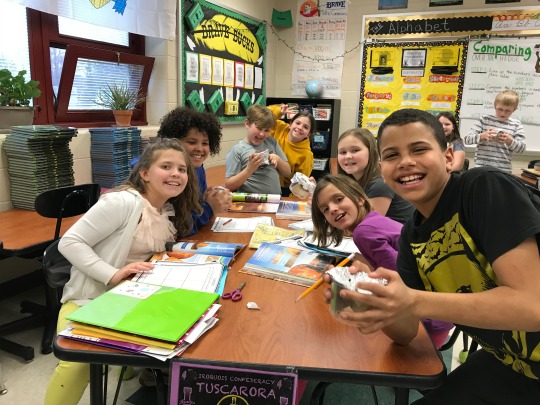
Sunday, December 29th, 2019 (COMPONENT #4)
As an educator, I am always looking for ways to improve my teaching style, the resources being implemented, and the strategies of how they are taught to ensure each and every one of my students are reaching their academic potential. Through Inspire Science! By McGraw Hill, students have access to an online textbook as well as STEM Module Projects, such that in Module: Earth and Its Changing Features, students are able to summarize their knowledge of erosion, deposition, and weathering by completing a module project online. Through ‘Don’t Get Carried Away,’ students apply what they have learned about Earth and its changing features to complete the models for the module project, which requires typing in textboxes online as to how they and their partners will conduct research to identify a problem caused by erosion and come up with at least two solutions on how to prevent it. Furthermore, they will build and test their model, which students will be completing in February, to determine which material or strategy works best. I love the complexity of the project and the ability for students to communicate their results as well as whether or not they met the criteria and constraints of ways they can improve their models.
Secondly, another phenomenal resource is Fusion Science through Houghton Mifflin Harcourt. Accessing ‘Science Fusion: History Channel,’ there are phenomenal resources such as visual videos that provide supplemental information as to how glaciers caused erosion in the Colorado River through flash floods-real life science events that have taken place to carve our Earth. I also love the aspect of Science Fusion providing differentiated instruction for ELL learners, since I have a Nepali student and an Arabic student in my classroom. These resources provide an opportunity for students to follow a digital path, which is broken down to allow ELL students to work at a modified pace. This is also beneficial for students who may have an IEP or require additional time to complete assignments, for the ease of pace allows everyone to benefit and comprehend the material. Lastly, as I was perusing materials on Science Fusion, the organization of topics and concepts is very structured, allowing teachers and students alike to see why we are learning a key topic or goal and how it is supported through various concepts.
Finally, as an avid kinesthetic teacher and learner, I was very impressed with ‘Mystery Science’ as a curriculum kit, for students in my classroom enjoy being evaluated through a hands-on approach. Through Mystery Science, students are posed with a question, such as ‘Will a mountain last forever?’ and asked to spend 20 minutes exploring the concept and then 45 minutes with a hands-on activity to evaluate, such as: in this Mystery, students will explore how solid rock breaks apart into smaller pieces through a process called weathering (including root-wedging and ice-wedging). In the activity, Sugar Shake, students use sugar cubes as a model for rocks. They perform an experiment with this model to understand the process of weathering and how this process explains why rocks at the tops of mountains are jagged, while those at the bottom are rounded. These phenomenal activities even include activity preps, materials required, and extension videos and readings. Mystery Science is by far my favorite resource due to its ease of accessibility and organization for both students and teachers.
0 notes
Text
How appropriate to see Evolving Science Standards pertain to ‘Practice 6: Constructing Explanations and Designing Solutions’ to support my science curriculum in having students design methods to reduce the impact of erosion on Lake Erie’s shoreline!
Eight Next Generation Science Standards: Science and Engineering Practices
The eight practices of science and engineering that the Framework identifies as essential for all students to learn and describes in detail are listed below: 1. Asking questions (for science) and defining problems (for engineering) 2. Developing and using models 3. Planning and carrying out investigations 4. Analyzing and interpreting data 5. Using mathematics and computational thinking 6. Constructing explanations (for science) and designing solutions (for engineering) 7. Engaging in argument from evidence 8. Obtaining, evaluating, and communicating information
Practice 1 Asking Questions and Defining Problems Students at any grade level should be able to ask questions of each other about the texts they read, the features of the phenomena they observe, and the conclusions they draw from their models or scientific investigations. For engineering, they should ask questions to define the problem to be solved and to elicit ideas that lead to the constraints and specifications for its solution.
Practice 2 Developing and Using Models Modeling can begin in the earliest grades, with students’ models progressing from concrete “pictures” and/or physical scale models (e.g., a toy car) to more abstract representations of relevant relationships in later grades, such as a diagram representing forces on a particular object in a system.
Practice 3 Planning and Carrying Out Investigations Students should have opportunities to plan and carry out several different kinds of investigations during their K-12 years. At all levels, they should engage in investigations that range from those structured by the teacher—in order to expose an issue or question that they would be unlikely to explore on their own (e.g., measuring specific properties of materials)—to those that emerge from students’ own questions.
Practice 4 Analyzing and Interpreting Data Once collected, data must be presented in a form that can reveal any patterns and relationships and that allows results to be communicated to others. Because raw data as such have little meaning, a major practice of scientists is to organize and interpret data through tabulating, graphing, or statistical analysis. Such analysis can bring out the meaning of data—and their relevance—so that they may be used as evidence. Engineers, too, make decisions based on evidence that a given design will work; they rarely rely on trial and error. Engineers often analyze a design by creating a model or prototype and collecting extensive data on how it performs, including under extreme conditions. Analysis of this kind of data not only informs design decisions and enables the prediction or assessment of performance but also helps define or clarify problems, determine economic feasibility, evaluate alternatives, and investigate failures.
Practice 5 Using Mathematics and Computational Thinking Although there are differences in how mathematics and computational thinking are applied in science and in engineering, mathematics often brings these two fields together by enabling engineers to apply the mathematical form of scientific theories and by enabling scientists to use powerful information technologies designed by engineers. Both kinds of professionals can thereby accomplish investigations and analyses and build complex models, which might otherwise be out of the question.
Practice 6 Constructing Explanations and Designing Solutions. The goal of science is the construction of theories that provide explanatory accounts of the world. A theory becomes accepted when it has multiple lines of empirical evidence and greater explanatory power of phenomena than previous theories.
Practice 7 Engaging in Argument from Evidence The study of science and engineering should produce a sense of the process of argument necessary for advancing and defending a new idea or an explanation of a phenomenon and the norms for conducting such arguments. In that spirit, students should argue for the explanations they construct, defend their interpretations of the associated data, and advocate for the designs they propose.
Practice 8 Obtaining, Evaluating, and Communicating Information Any education in science and engineering needs to develop students’ ability to read and produce domain-specific text. As such, every science or engineering lesson is in part a language lesson, particularly reading and producing the genres of texts that are intrinsic to science and engineering.
Reference: Next Generation Science Standards: Appendix F-Science and Engineering Practices in the NGSS. Retrieved from http://www.nextgenscience.org/sites/ngss/files/Appendix%20F%20%20Science%20and%20Engineering%20Practices%20in%20the%20NGSS%20-%20FINAL%20060513.pdf
1 note
·
View note
Photo
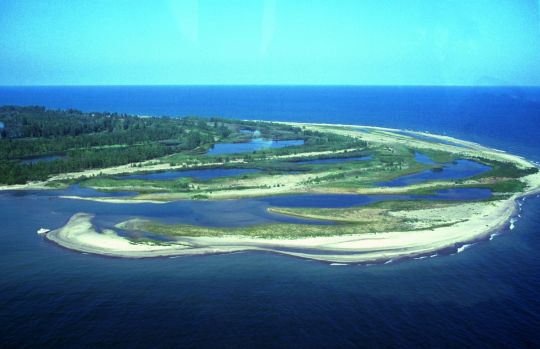
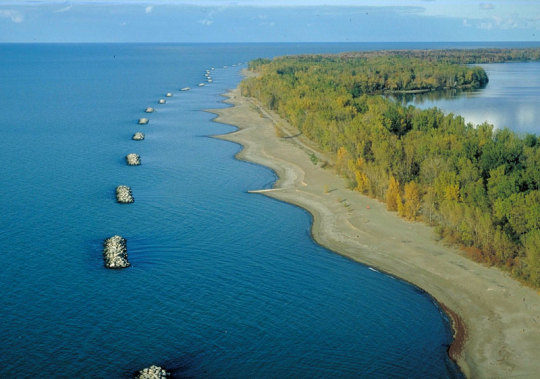

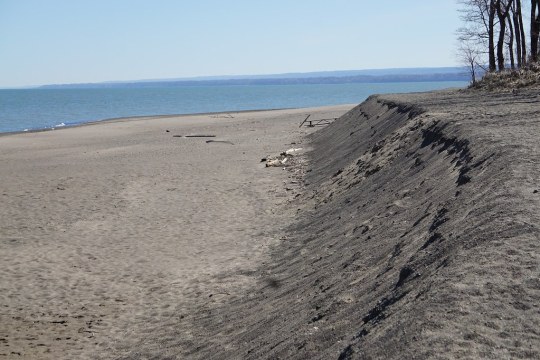
Sunday, December 29th, 2019 (COMPONENT #3)
As a fourth grade science educator, there are three major components I implement to not only engage my students, but also provide a unique style of learning based off of research practices. Through implementing the 5E Model, the Mozart Effect, and Inquiry-Based Learning into my science curriculum, my students are challenged as we investigate essential questions. According to research on our evolving science standards, conducted by Anderson et al (2018), “NGSS describe goals for science learning as three-dimensional engagement with phenomena: Students should use crosscutting concepts and disciplinary core ideas as they engage in scientific practices focused on phenomena in the material world” (p. 1027). Later this year, my students and I will be traveling to the Tom Ridge Environmental Center to meet Dr. Schnars, as we walk along the beaches of Presque Isle to see how water affects erosion along our shoreline—addressing one of our essential questions in ‘How does weathering, erosion, and deposition change the land where people live?’ to engage in scientific practices that affect the material world.
One major component to my science curriculum that I implement for my elementary instruction is the 5E Model. I personally find the ‘Elaborate’ phase to be the most essential component. Through Rodger Bybee, creator of the 5E Model, Claymier (2012) states, “teaching science through design draws connections between science and daily life, nurtures critical and creative thinking, problem solving, and decision making. It focuses the students’ attention on ‘doing something’ rather than ‘knowing something’” (p. 5), where students are constantly exploring the world around them to problem solve using the elaborate phase to ‘do something,’ which requires kinesthetic learning. During the elaborate phase of Dr. Schnars’s visit, we had students apply their understanding of what was previously taught to conduct a hands-on experience to test conceptual knowledge, where they paired up to share their findings of erosion. Biggers et al (2013), who has studied new methodology towards the 5E model states, “…the importance of engaging students in comparing and evaluating explanations through exchanges with their peers in the classroom, where students would compare and critique each other’s explanations based on evidence” (p. 60), is of great importance, for students are interacting with classmates to propose solutions and make decisions as to how they will reduce erosion.
Secondly, I implement the ‘Mozart Effect,’ which was conceptualized by the late physicist Gordon Shaw, to enhance my science curriculum, as well as STEAM. Through the Mozart Effect, I dress up as DJs, such as DJ Rock-I, DJ Iggy, and DJ EroZion, to not only engage my students based off of their interest, but provide a musical avenue for my auditory learners. According to Burack (2005), “Shaw led a number of landmark studies that established the connection between active participation in music and the development of the brain, with demonstrated implications for spatial-temporal reasoning and math ability” (p. 84), where I stimulate and engage my student’s brains for new content. Burack (2005) stated, “Shaw recognized that ‘music is a window to a higher brain function’” (p. 84), where I use the Mozart Effect approach to enhance activating new areas of brain function. Through the ‘Arts’ of STEAM, music has become a staple in my elementary science instruction, where I strive to reach all students through catchy lyrics and addictive songs to help memorize material.
Finally, a third theory I use to structure my science curriculum is inquiry-based learning. This approach is the most crucial to our essential questions used to determine how weathering, erosion, and deposition affect people. According to Potgieter et al (2019), “identifying problems, formulating questions, designing and conducting investigations and formulating, communicating and defending hypotheses,” are all prime examples of using the scientific method (p. 13723). Through implementing inquiry-based learning, students are inquisitive about the world around them, which I think is one of the most influential components of guiding my classroom through instruction, especially since the problem being addressed is literally in the backyards of my students. According to research by Fulmer et al (2018), who studies the Next Generation Science Standards, “The Framework describes eight practices, such as ‘Asking questions (for science) and defining problems (for engineering)’ and ‘Analyzing and interpreting data.’ CCCs are concepts that extend across scientific disciplines and are useful for explaining science as an overarching approach to knowledge development” (p. 1081). This finding fuels my science instruction through inquiry-based learning, where my students are motivated to learn more about a real-world problem while understanding how to test variables to make solutions.
References
Anderson, C. W. 1. andya@msu. ed., de los Santos, E. X. ., Bodbyl, S., Covitt, B. A. ., Edwards, K. D. ., Hancock, I. J. B., … Welch, M. M. (2018). Designing educational systems to support enactment of the Next Generation Science Standards. Journal of Research in Science Teaching, 55(7), 1026–1052. https://doi.org/10.1002/tea.21484
Biggers, M., Forbes, C. T., & Zangori, L. (2013, September). Elementary teachers' curriculum design and pedagogical reasoning for supporting students' comparison and evaluation of evidence-based explanations. The Elementary School Journal, 114(1), 48-72. doi:10.1086/670738
Burack, J. (2005). Uniting mind and music. American Music Teacher, 55(1), 84. Retrieved from http://search.ebscohost.com.proxy-sru.klnpa.org/login.aspx?direct=true&db=asn&AN=17814342&site=ehost-live
Claymier, B. (2012). Integrating science and engineering education. Children’s Technology & Engineering, 17(2), 5. Retrieved from http://search.ebscohost.com.proxy-sru.klnpa.org/login.aspx?direct=true&db=asn&AN=84205698&site=ehost-live
Fulmer, G. W. 1. gavin-fulmer@uiowa. ed., Tanas, J., & Weiss, K. A. . (2018). The challenges of alignment for the Next Generation Science Standards. Journal of Research in Science Teaching, 55(7), 1076–1100. https://doi.org/10.1002/tea.21481
Tsakeni, M., Vandeyar, S., & Potgieter, M. (2019). Inquiry opportunities presented by practical work in school physical sciences. A South African case study. Gender & Behaviour, 17(3), 13722–13733. Retrieved from http://search.ebscohost.com.proxy-sru.klnpa.org/login.aspx?direct=true&db=asn&AN=139753119&site=ehost-live
0 notes
Photo
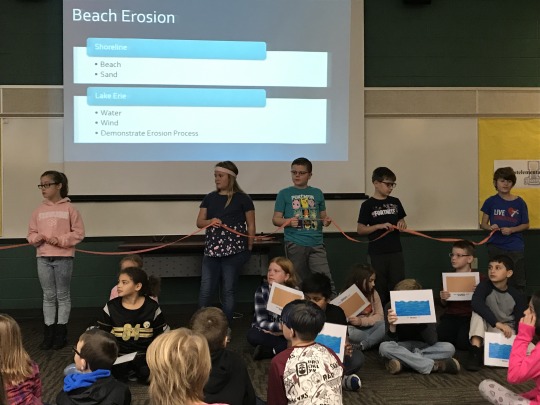
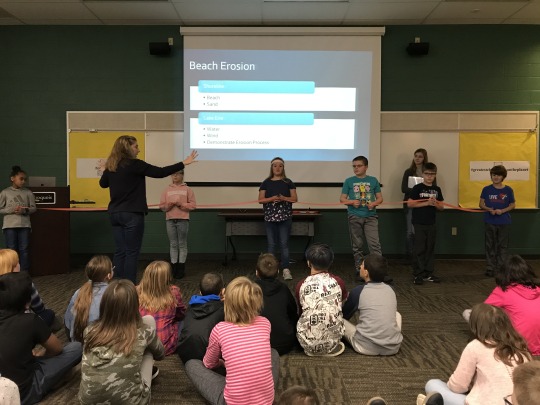
Sunday, December 29th, 2019 (SUPPLEMENTAL MATERIAL)
As part of our grant through the Regional Science Consortium, my co-workers and I invited Jeanette Schnars, Director at the Tom Ridge Environmental Center, to come to Iroquois Elementary to share a hands-on lab as to how erosion affects our Lake Erie Shoreline-which is literally in the backyard of a handful of my students. Supporting my philosophy towards our science curriculum, this method of inquiry-based learning allowed students to not only act out the roles of shoreline, waves, wind, water, rocks, etc., but also hypothesize what would happen to our shoreline with erosion when rock barriers are added to the shoreline. Students were thoroughly engaged with this approach as they participated in creating erosion and in learning of the effects of erosion to the Lake Erie shoreline. It certainly sparked their interest, as they have now started developing and brainstorming how they can reduce the impact of erosion along our shoreline to protect our properties from the effects of Mother Nature.
0 notes
Photo
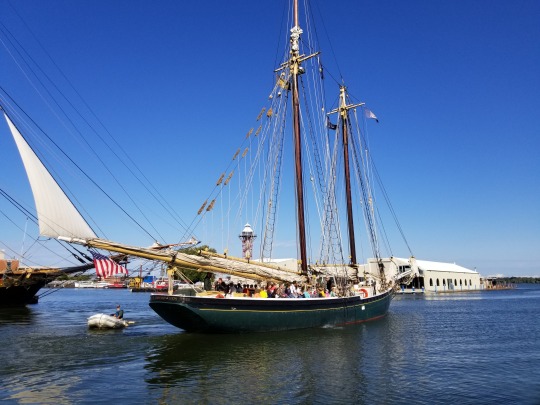
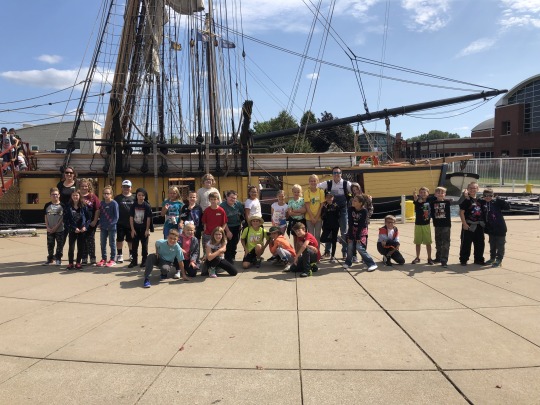
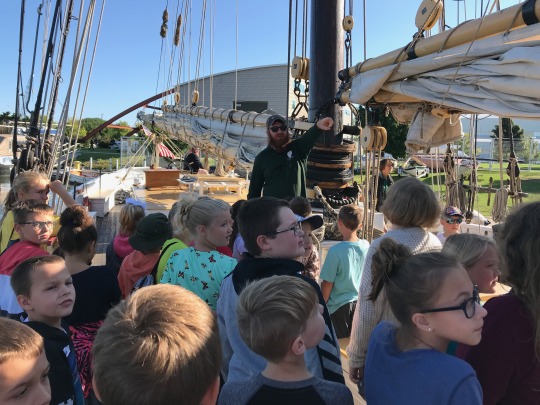
Thursday, December 19th, 2019 (COMPONENT #2)
Through a grant that was obtained between my co-workers and I at Iroquois Elementary School, The Regional Science Consortium and Iroquois School District have partnered with third and fourth grade educators in the Erie Metropolitan Area to learn more about our own backyard. Students were even privileged to sail on the Lettie G. Howard, explore our hometown ship of the U.S. Brig Niagara, and navigate through the Erie Maritime Museum to learn of the importance of Erie’s geography and naval pastime. In doing so, we are learning about the importance of Lake Erie and its shoreline as well as how to protect it. Our goal of our program is for our students to develop a model of Lake Erie, where we will study the specific effects of erosion, deposition, and weathering that is literally occurring in my students’ backyards. We will be taking another field trip to the Tom Ridge Environmental Center in early February to explore Presque Isle State Park in the dead of winter to see how various forms of water (solid ice and liquid water) affect the erosion of our shoreline. Students will then brainstorm how to take protective measures to retain our shoreline through the use of planting native plants, developing retention walls, dumping rocks/gravel, etc. Through making an actual model and providing examples and testing their hypotheses, students will gain a thorough understanding of what preventative measures work best to protect our land forms of our shoreline and how air, water, and soil interact with one another.
GRADE LEVEL AND STANDARD:
Fourth Grade
Pennsylvania Standard - 3.3.4.A6
MODELS/SCALE
Identify basic landforms using models and simple maps.
CONSTANCY/ CHANGE
Identify simple changes in the earth system as air, water, soil and rock interact.
SCALE
Explain how basic weather elements are measured.
ESSENTIAL QUESTIONS:
Why is Lake Erie’s shoreline changing shape?
What causes Lake Erie’s shoreline to change size?
How does the changing shoreline affect people living in Lakecliff?
How is the land changing along Lake Erie’s shoreline?
What are strategies we can use to reduce erosion?
What materials would work best to hold the shoreline in place?
STANDARDS:
S4.A.3.2.1 Identify what different models represent (e.g., maps show physical features, directions, distances; globes represent Earth; drawings of watersheds depict terrain; dioramas show ecosystems; concept maps show relationships of ideas).
S4.A.3.2.2 Use models to make observations to explain how systems work (e.g., water cycle, Sun-Earth-Moon system).
S4.A.3.2.3 Use appropriate, simple modeling tools and techniques to describe or illustrate a system (e.g., two cans and string to model a communications system, terrarium to model an ecosystem).
S4.C.1.1.1 Use physical properties [e.g., mass, shape, size, volume, color, texture, magnetism, state (i.e., solid, liquid, and gas), conductivity (i.e., electrical and heat)] to describe matter
S4.D.1.1.1 Describe how prominent Earth features in Pennsylvania (e.g., mountains, valleys, caves, sinkholes, lakes, rivers) were formed.
S4.D.1.1.2 Identify various Earth structures (e.g., mountains, watersheds, peninsulas, lakes, rivers, valleys) through the use of models.
S4.D.1.1.3 Describe the composition of soil as weathered rock and decomposed organic remains.
S4.D.1.2.2 Identify the types and uses of Earth materials for renewable, nonrenewable, and reusable products (e.g., human-made products: concrete, paper, plastics, fabrics).
S4.D.1.2.3 Recognize ways that humans benefit from the use of water resources (e.g., agriculture, energy, recreation).
S4.D.1.3.1 Describe types of freshwater and saltwater bodies (e.g., lakes, rivers, wetlands, oceans).
S4.D.1.3.2 Explain how water goes through phase changes (i.e., evaporation, condensation, freezing, and melting).
S4.D.1.3.4 Explain the role and relationship of a watershed or a wetland on water sources (e.g., water storage, groundwater recharge, water filtration, water source, water cycle).
1 note
·
View note